What’s a Perfect Square?
A natural number n is a perfect square if n = m², where m is a natural number. So, when a number is the square of another number, it’s called a perfect square!
Example:
9 = 3² (The square of 3 is 9)
25 = 5² (The square of 5 is 25)
Digits of a Perfect Square:
- If a number ends in 2, 3, 7, or 8, it can never be a perfect square.
- The squares of even numbers are even, and the squares of odd numbers are odd.
- A number ending in an odd number of zeros cannot be a perfect square.
Between Two Squares:
- Between n² and (n+1)², there are exactly 2n non-perfect square numbers!
The Pythagorean Triplet Connection:
- For any natural number n greater than 1, the numbers 2n, (n² - 1), and (n² + 1) form a Pythagorean triplet.
Square Roots
- The square root is the opposite of squaring a number!
Example: If you square 4, you get 16. If you take the square root of 16, you get 4.
Number of Digits in Square Numbers
If a number n has n digits, then the number of digits in its square root is:
- n/2 if n is even.
- (n+1)/2 if n is odd.
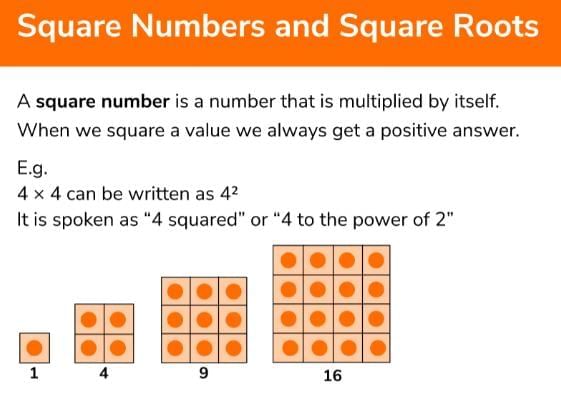
[Question: 694414]
Square of a Number:
- When you multiply a number by itself, it's called squaring that number.
Example:
3 × 3 = 9 (This means 9 is the square of 3!)
5 × 5 = 25 (This means 25 is the square of 5!)
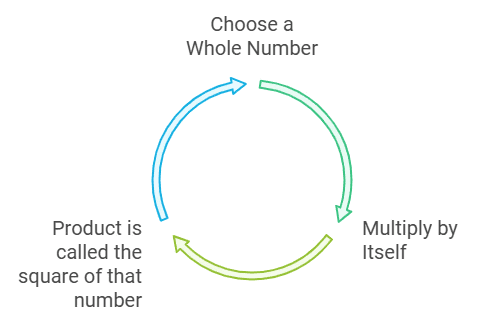
Perfect Square:
- A number like 16, which can be expressed as 4², is called a perfect square! But remember, not every number is a perfect square. For example, 32 is not a square number. So, always check if a number is the square of another number.
Remember
All-natural numbers are not perfect squares or square numbers, 32 is not a square number. In general, if a natural number ‘m’ can be expressed as n2, where n is also a natural number, then ‘m’ is the perfect square. The numbers like 1, 4, 9, 16, 25, and 36 are called square numbers.
Table: Square of numbers from 1 and 10.
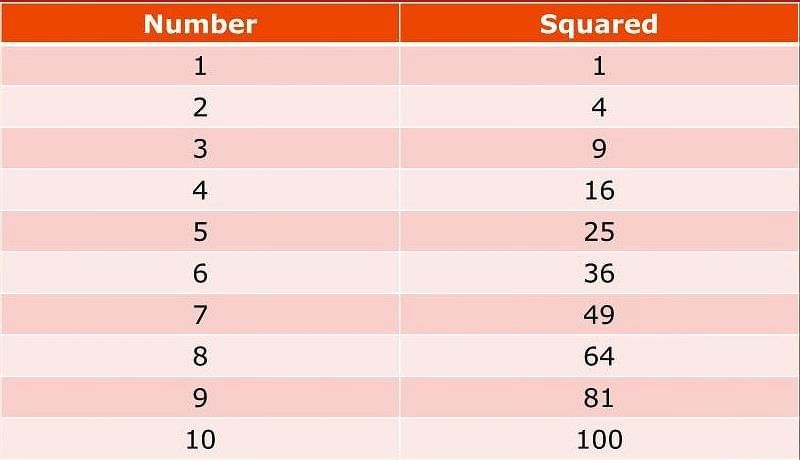
Properties of Square Number
Table: Let us consider the square of all natural numbers from 1 to 20.
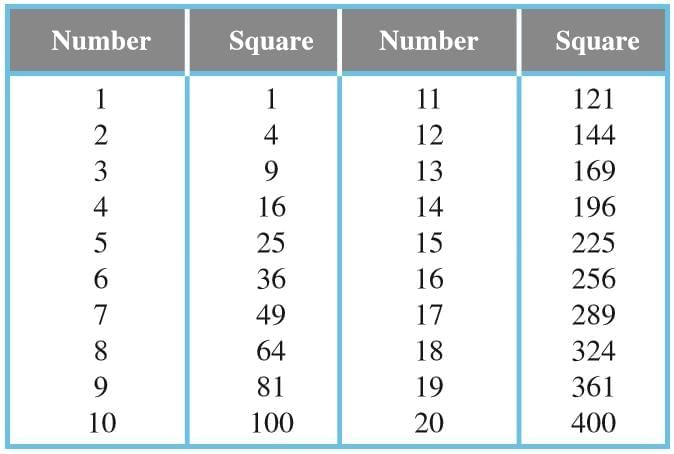
From the table, we conclude that:
Property 1: “The ending digits (the digits in the one’s place) of a square number is 0, 1, 4, 5, 6 or 9 only.”
[Question: 694416]
Some Interesting Patterns
- Triangular numbers are: 1, 3, 6, 10, 15, 21, etc. If we combine two consecutive triangular numbers, we get a square number.
1 + 3 = 4, ‘4’ is a square number
3 + 6 = 9, ‘9’ is a square number
6 + 10 = 16, ‘16’ is a square number
and so on.

- 12 =1
112 = 121
1112 = 12321
11112 = 1234321 - 72 = 49
672 = 4489
6672 = 444889
66672 = 44448889 and so on.
Cube of a number
A natural number multiplied by itself three times gives a cube of that number, e.g.
1 × 1 × 1 = 1
2 × 2 × 2 = 8
3 × 3 × 3 = 27
4 × 4 × 4 = 64
The numbers 1, 8, 27, 64, … are called cube numbers or perfect cubes.
Perfect Cube: A number is a perfect cube if it can be expressed as n3 for some integer n.
Prime Factor Test: In the prime factorization of a perfect cube, every prime factor appears in groups of three.
Cube Root of a Number
The cube root of a number is the side length of a cube whose volume is that number.

is the inverse operation of cubing x.For example :

This means the cube root of 8 is 2.
Prime Factorization Method: Factorize the number, group identical factors in threes, and multiply one factor from each triplet to get the cube root.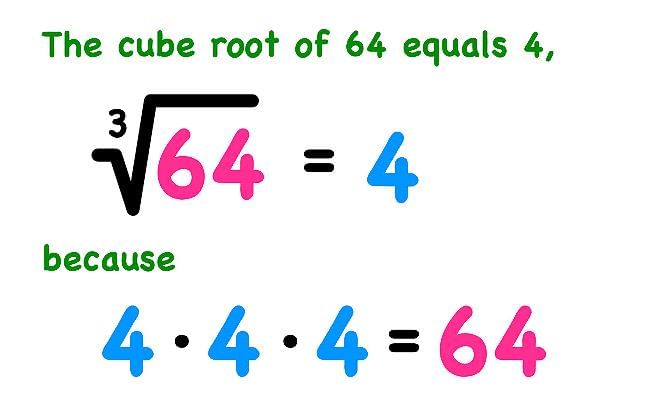
Steps to Calculate Cube Root
1. Prime Factorize the Number
Break the number down into its prime factors.
For example: Prime Factorize 8000
8000 = 2 × 2 × 2 × 2 × 2 × 2 × 5 × 5 × 5
2. Group the Factors in Threes
Arrange identical factors into sets of three.
8000 = (2 × 2 × 2) (2 × 2 × 2) (5 × 5 × 5)
3. Multiply One Factor from Each Triplet
From each group of three identical primes, take one prime and multiply them together.
8000 = (2 × 2 × 2) (2 × 2 × 2) (5 × 5 × 5)
Picking one prime from each triplet: 2 × 2 × 5 = 20
4. Result
The product you get in Step 3 is the cube root of the original number.
Therefore, cube root of 8000 is 
[Question: 1284091]
Properties of Perfect Cubes
(a) Property 1
If the digit in the one’s place of a number is 0, 1, 4, 5, 6 or 9, then the digit in the one’s place of its cube will also be the same digit.
(b) Property 2
If the digit in the one’s place of a number is 2, the digit in the one’s place of its cube is 8, and vice-versa.
(c) Property 3
If the digit in the one’s place of a number is 3, the digit in the one’s place of its cube is 7 and vice-versa.
Examples of Properties 1, 2 & 3
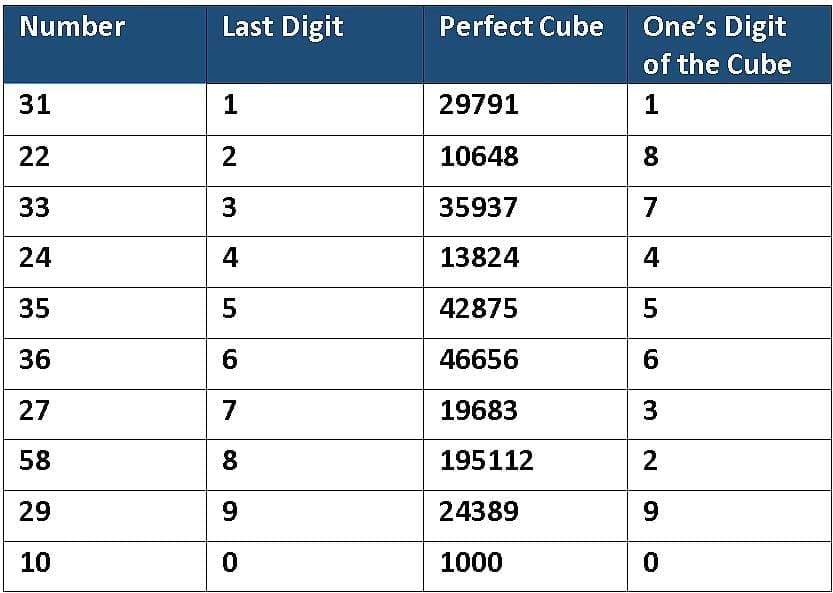
(d) Property 4
Cubes of even natural numbers are even.
Examples of Property 4
(e) Property 5
Cubes of odd natural numbers are odd.
Examples of Property 5

(f) Property 6
Cubes of negative integers are negative.
Examples of Property 6
Some Interesting Patterns in Cubes
1. Adding consecutive odd numbers
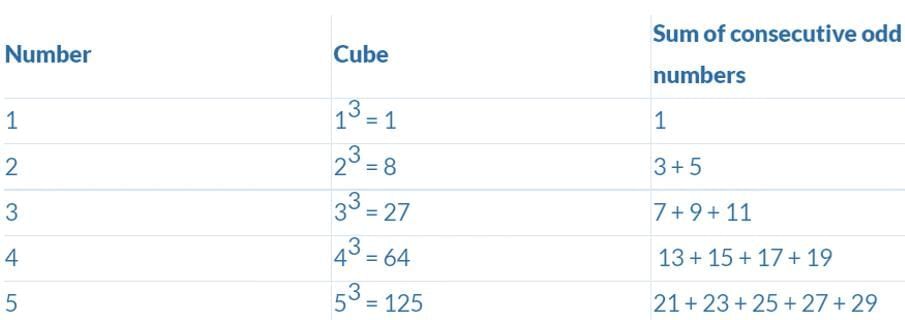
Note that we start with [n * (n – 1) + 1] odd number.
2. Difference of two consecutive cubes:
23 – 13 = 1 + 2 * 1 * 3
33 – 23 = 1 + 3 * 2 * 3
43 – 33 = 1 + 4 * 3 * 3
53 – 43 = 1 + 5 * 4 * 3
3. Cubes and their prime factor
Each prime factor of the number appears three times in its cube.
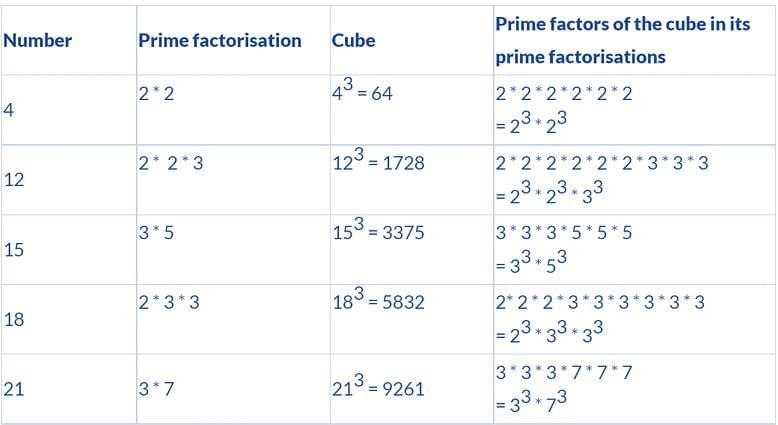
Facts That Matter
- If we multiply a number by itself three times, the product so obtained is called the perfect cube of that number.
- There are only 10 perfect cubes from 1 to 1000.
- Cubes of even numbers are even and those of odd numbers are odd.
- The cube of a negative number is always negative.
- If the prime factors of a number cannot be made into groups of 3, it is not a perfect cube.
[Question: 1284092]








 is the inverse operation of cubing x.For example :
is the inverse operation of cubing x.For example : 



























